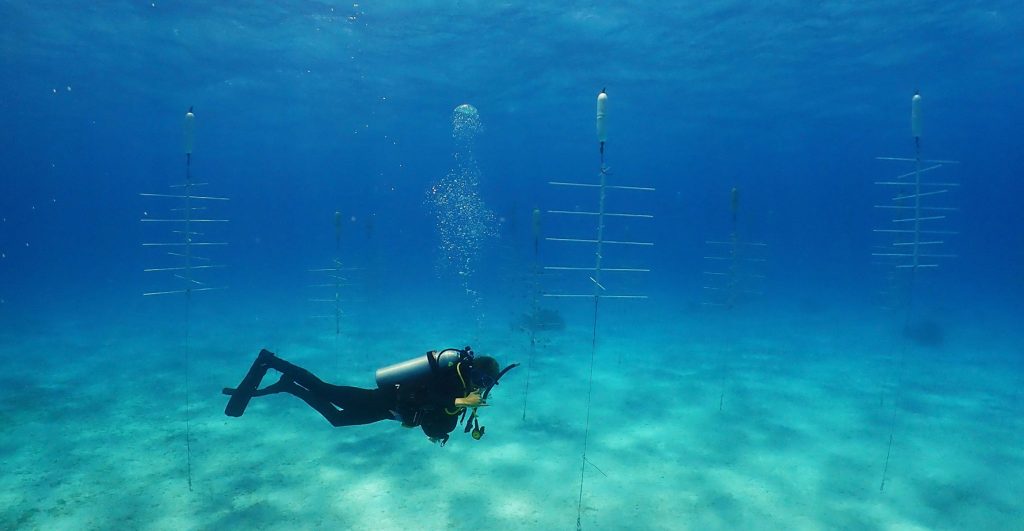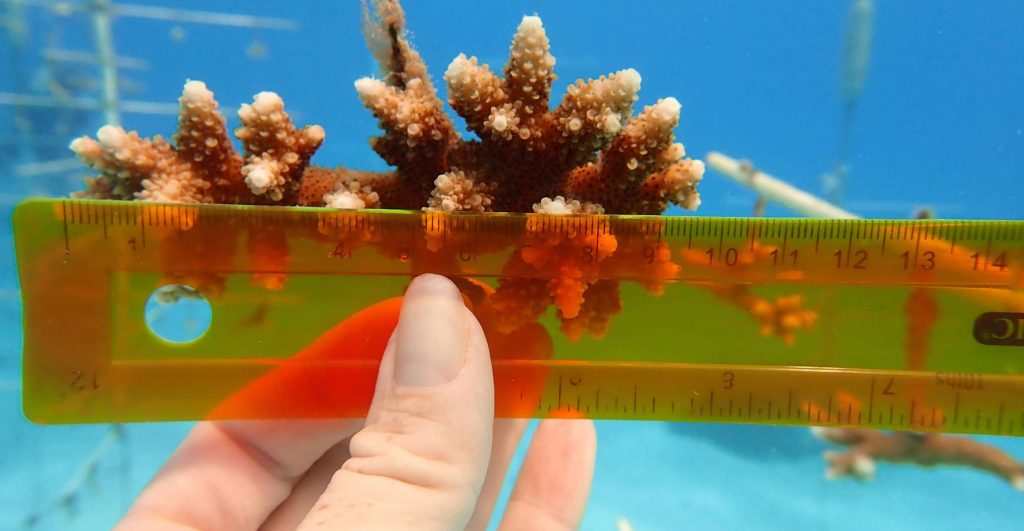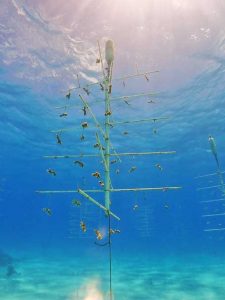SAVING CORALS:
Coral culture and restoration through the Saipan Pilot Coral Nursery

Johnston Applied Marine Sciences intern Logan Mister scuba diving at the Saipan Pilot Coral Nursery. The project is funded by the National Oceanic and Atmospheric Administration, and is being implemented by Johnston Applied Marine Sciences, with the CNMI Division of Fish and Wildlife and the Division of Coastal Resources Management, to help restore corals in the CNMI. (Photos by JOHNSTON APPLIED MARINE SCIENCES)
“While coral reefs here in the CNMI remain in fair condition, they are vulnerable and declining.”
This is according to the recently released status report on the U.S. Coral Reefs by the National Oceanic and Atmospheric Administration’s Coral Reef Conservation Program, where, along with Hawaii, American Samoa, Guam, and the Pacific Remote Islands, NOAA has found that frequent and severe heat stress caused by the rapidly changing climate have been causing coral bleaching and deaths to happen in the CNMI reefs.
It’s not hard to see that corals on the island are under threat. A swim, snorkel, or a dive is all it takes to get close to corals and really observe how they are slowly dying.
Thankfully, for the CNMI, “human connections to coral reefs are good”—with NOAA noting that residents, aware of these threats, support coral reef management and demonstrate high engagement in behaviors that are aligned with environmental protection.
People on the island are working together to help save our corals.
Last month, Saipan Tribune featured and joined in the pilot training of students for the citizen science program on coral protection, Eyes of the Reef Marianas, organized by the Division of Coastal Resources Management of the Bureau of Environmental and Coastal Quality. Today, we highlight the Saipan Coral Nursery Project being piloted by the Johnston Applied Marine Sciences.
The Saipan Pilot Coral Nursery
“Since 2013, the CNMI coral reefs have experienced several thermal stress events where the seawater temperatures got so hot that the corals got stressed out and many of them died. Based on a study that we conducted, over 60% of corals were lost on Saipan’s shallow reefs from 2012 to 2018.”
According to Dr. Lyza Johnston, coral reef ecologist and founder of the Johnston Applied Marine Sciences, based in the CNMI, the Saipan Pilot Coral Nursery was established in 2019 to give local resource managers a way to help restore the coral reefs after these losses.
The coral culturing and restoration project was funded by NOAA and is being implemented by Johnston Applied Marine Sciences, with the CNMI Division of Fish and Wildlife and the Division of Coastal Resources Management.
The project features nursery trees where coral fragments are placed to grow further. The nursery is located in the Saipan lagoon, within the Managaha Marine Conservation Area.
“We currently have 20 ‘tree’ structures in the nursery which can hold up to 100 corals each. The trees have a 5-inch PVC spine and ten fiberglass arms. The coral fragments are secured and hung from the arms using monofilament fishing line, much like ornaments on a Christmas tree.”
Johnston states that the trees are ideal for growing branching corals, and that they will also soon be adding table structures to the nursery, in order to grow boulder corals.
“We currently have nine species of coral growing in the nursery. We generally collect several small fragments from wild donor, or parent, colonies (no more than 10% of the colony) and bring them to the nursery to grow and propagating within the nursery.”
The said strategy, Johnston affirms, minimizes the impacts to wild donor colonies.

Coral growth being measured at the Saipan Pilot Coral Nursery. The project is funded by the National Oceanic and Atmospheric Administration, and is being implemented by Johnston Applied Marine Sciences, with the CNMI Division of Fish and Wildlife and the Division of Coastal Resources Management, to help restore corals in the CNMI.
“So far, we have collected from over 50 donor colonies at 12 sites located all around Saipan. The parent colonies are monitored after collection and so far, the vast majority (over 99%) have recovered fully from the collection process,” she added.
As for the coral colonies that will grow from the nursery, they will be planted back out to the degraded reef sites around Saipan where coral covers were found to have declined due to bleaching, typhoons, or other disturbances.
What can the community do to help?
Corals and coral reefs are extremely vital in protecting islands like the CNMI—and given the threat they are facing in terms of bleaching and mortality, we need to help them recover.
“Coral reefs are very important to island communities because they provide food and habitat for many important fisheries species, which, in turn, provide income and sustenance to the community; they protect coastlines from damaging waves, reducing coastal erosion and flooding; and they provide tourism and recreation opportunities.”
As local efforts, such as the Coral Nursery Project and the Eyes of the Reef, are helpful in protecting and restoring the islands coral reefs, with climate change as a major factor in the bleaching, NOAA also stresses the need to cut carbon emissions, and transition from fossil fuels to renewable sources of energy.
And for us, residents, we too can help, even in small ways. Many of our actions on land affect the nearshore coral reefs, and Johnston shares the following easy-to-follow guidelines that we all can do to keep coral reefs healthy:
1. Dispose of waste properly. Trash and other waste products such as motor oil, cooking oil, and other toxic chemicals, if left or dumped on the ground, can be blown or washed into the ocean and negatively impact coral reef ecosystems. Volunteer for beach cleanups or other conservation initiatives.

One of the “coral trees” at the Saipan Pilot Coral Nursery, established in 2019, to give local resource managers a way to help restore the coral reefs after the losses due to thermal stresses on Saipan’s shallow reefs from 2012 to 2018. The project is funded by the National Oceanic and Atmospheric Administration, and is being implemented by Johnston Applied Marine Sciences, with the CNMI Division of Fish and Wildlife and the Division of Coastal Resources Management.
2. When snorkeling or diving, don’t step on, kick, or touch corals or other organisms and try not to stir up sediments. Also, choose “reef-friendly” sunscreens whenever possible.
3. When boating, don’t drive over shallow areas of seagrass or coral reef; stirred up sediments and physical contact with the bottom will harm coral reef ecosystems. Also, try not to anchor on corals or seagrasses.
4. Plant a tree or a rain garden! Coastal erosion leads to sediments and other pollutants being washed out into the ocean. Vegetation, including trees and wetland plants, help to reduce erosion and filter sediments and other pollutants from the water before it reaches the sea.
5. Fish and buy fish responsibly. Coral reefs need herbivores, such as parrotfish, to eat fast growing algae (i.e., seaweed) that otherwise would overgrow corals and reduce habitat quality for coral juveniles and other animals. Follow all local fishing regulations and recommendations and only take what you need.
The Saipan Coral Nursery Project will continue indefinitely, provided funding is secured. Johnston also disclosed that the CNMI Division of Coastal Resources Management will be establishing a second nursery in the coming year, and that with other agencies and non-government organizations, a coral reef restoration plan is being developed for the CNMI.
For more information about the Coral Nursery, other coral projects, or in volunteering with the Johnston Applied Marine Sciences, please contact Kelsey McClellan at kmcclellan@jamssaipan.com.























